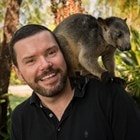Prehistoric platypuses with bite

John Pickrell
John Pickrell

WAS THIS ANIMAL for real? It sounded more like something from a poorly scripted, low-budget horror film. Could an ancient relative of everyone’s favourite venomous, duck-billed, egg-laying mammal really have grown to epic proportions and had a taste for flesh?
I could picture the scene through the Hollywood lens: maniacal monotremes marauding through the sewers of Sydney, ready to burst out of drains and clamp their bills around the ankles of unsuspecting pedestrians, dragging them to their untimely deaths.
Implausible as it all sounded, this prehistoric Platyzilla really did exist, even if descriptions of it were a little overblown in the press. Researchers led by Professors Mike Archer and Sue Hand, at the University of New South Wales (UNSW), announced late in 2013 that they’d discovered remains of a metre-long species, which had powerful teeth for preying upon turtles, frogs and fish.
Riversleigh fossil fauna
Obdurodon tharalkooschild inhabited pools and rivers in the rainforests that covered Queensland’s Riversleigh region 5–15 million years ago.
The description of this animal as “giant” in news reports conjured images of an animal the size of a small car, so I was disappointed to find it had been much smaller. Nevertheless, by monotreme standards this was huge.
Today’s platypus is about half a metre in length and, as an adult, doesn’t have teeth, instead relying on horny pads in its bill to crunch up invertebrates. Although O. tharalkooschild was only twice as long as a modern platypus, it is likely to have been about four times the weight.
Former UNSW student Rebecca Pian, now at Columbia University in the USA, discovered a fossil tooth at the Riversleigh World Heritage Area in 2012. The size and eating habits of the new species were later determined from a detailed study of the size, shape and function of the tooth, which is yet to be dated definitively.
Fossil discoveries over the past 40 years have given us snippets of information about platypus evolution, and have shown that similar animals have been a part of the Australian story for at least 110 million years. The most ancient platypuses were also found in Antarctica, South America and possibly Madagascar. By around 25 million years ago, they were left only in Australia, where up to three species shared the streams of the lush north and centre of the continent.
First fossil platypuses
In 1975, the first known ancient platypus was described from fossilised teeth found in central Australia, by Mike Archer and US palaeontologists Michael Woodbourne and Richard Tedford. They named the 26-million-year-old species Obdurodon insignis. Obdurodon means “persisting tooth”
A second toothed platypus, Obdurodon dicksoni, was discovered by Mike Archer’s group at Riversleigh in 1984 and dated to about 15 million years ago. Even more exciting was the discovery of the teeth of a 61-million-year-old South American relative in 1992. Hailing from Patagonia, Monotrematum sudamericanum demonstrated how widespread these early platypuses really were.
The newest species is significant because it is much larger than any of the other five known relatives, suggesting that the family tree is more complicated than we thought, with unexpected side branches. This hints that there may be other weird and fascinating platypus relatives waiting to be discovered in Riversleigh’s rich fossil deposits.
The species descriptor tharalkooschild comes from an Aboriginal creation story about the platypus: Tharalkoo was a disobedient female duck who ignored her parents’ warnings and swam downstream, where she was ravished by a water rat. Later, when she laid her eggs along with the other young ducks, she was horrified to discover it contained not a duckling but a platypus, with a mixture of rat and duck features.
This indigenous cautionary tale was then itself a horror story of sorts, one which had been told and retold over countless generations.
This column, first published in the Jan/Feb 2014 print edition of Australian Geographic, has been selected for inclusion in the Best Australian Science Writing 2014 anthology.
John Pickrell is the author of Flying Dinosaurs: How fearsome reptiles became birds, published by NewSouth Books in June 2014. Follow him on Twitter @john_pickrell.




